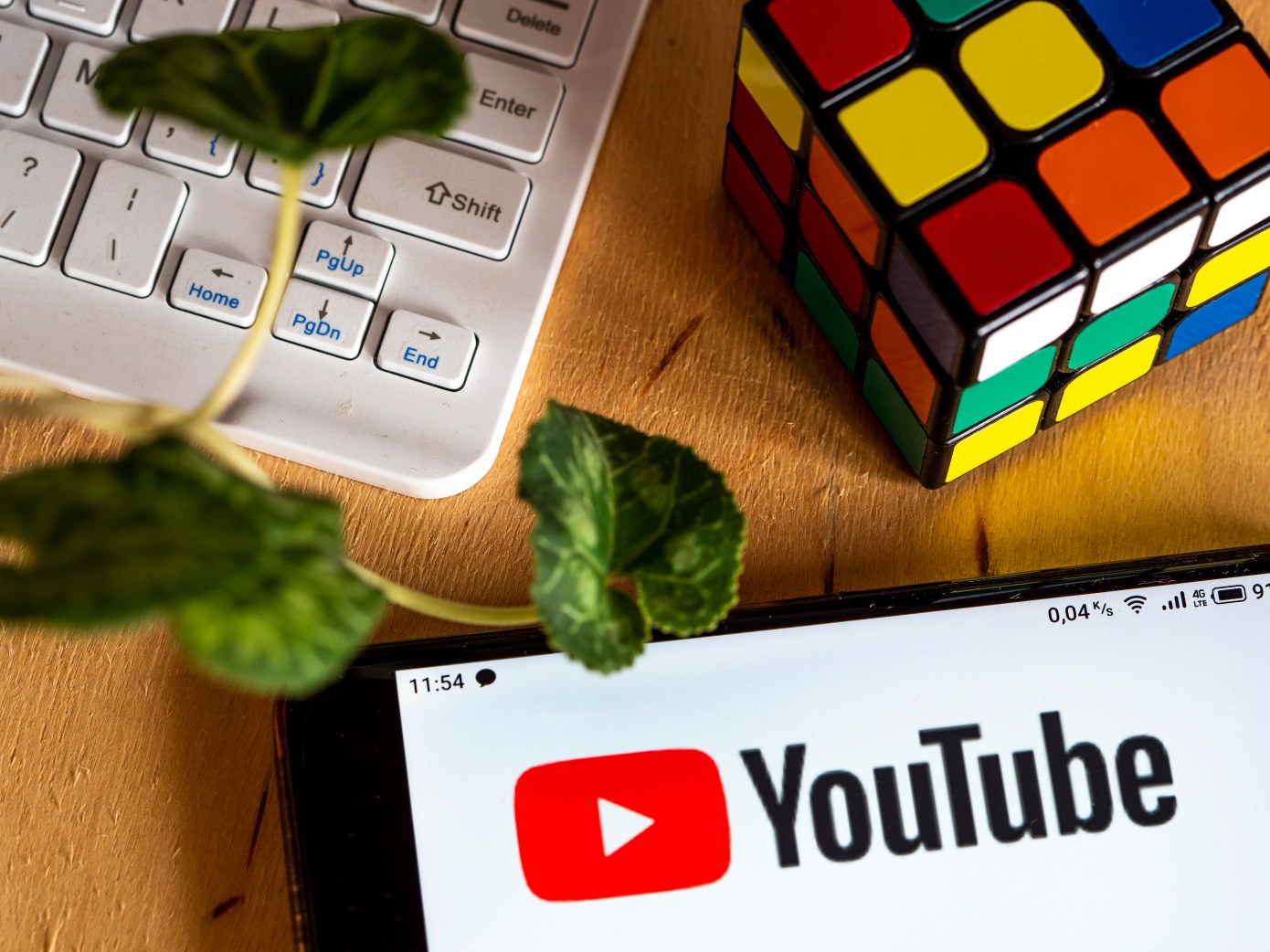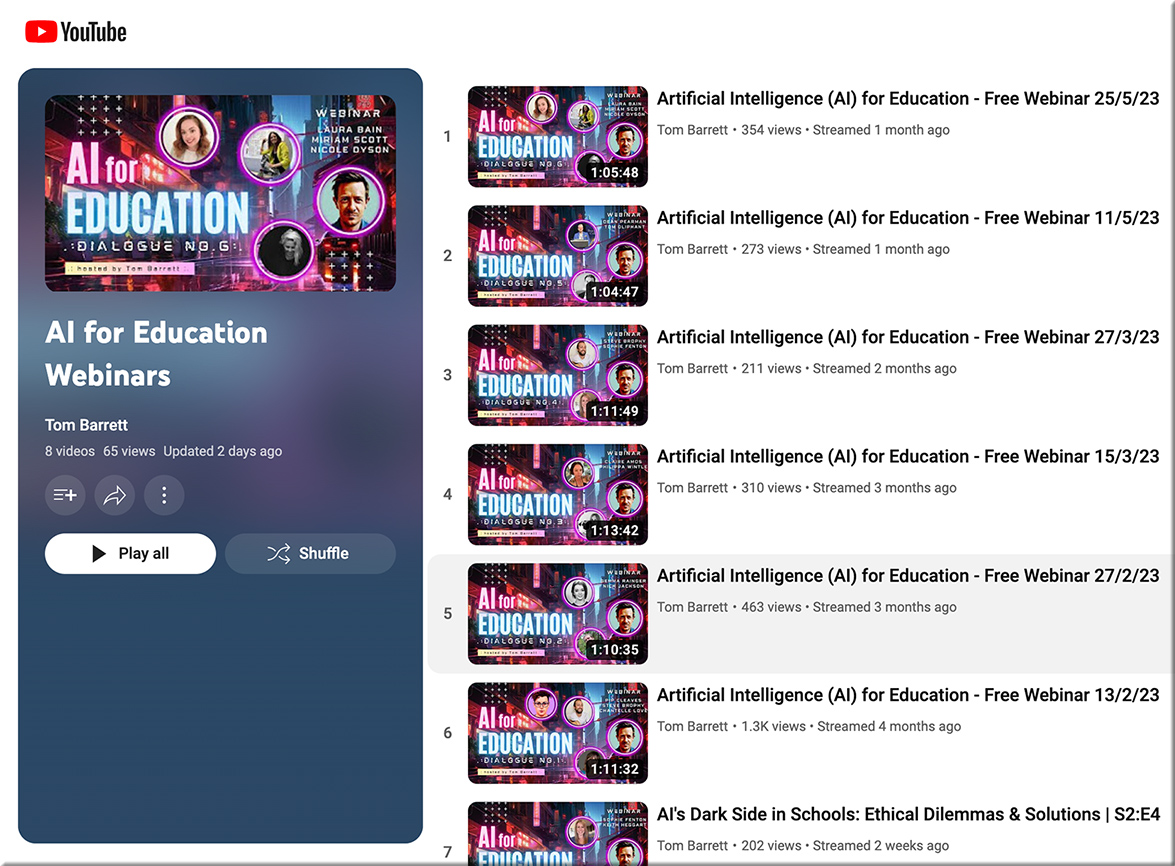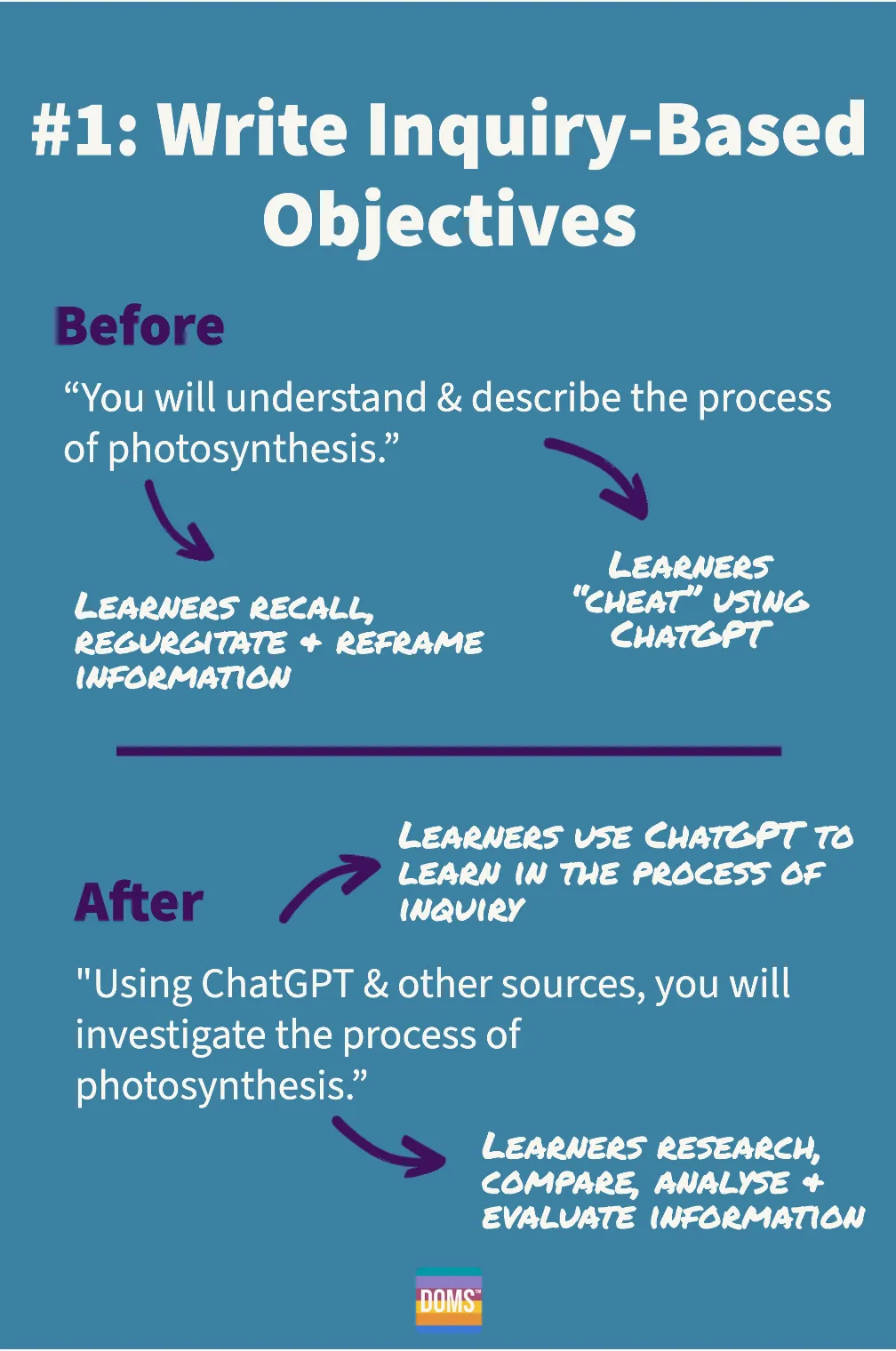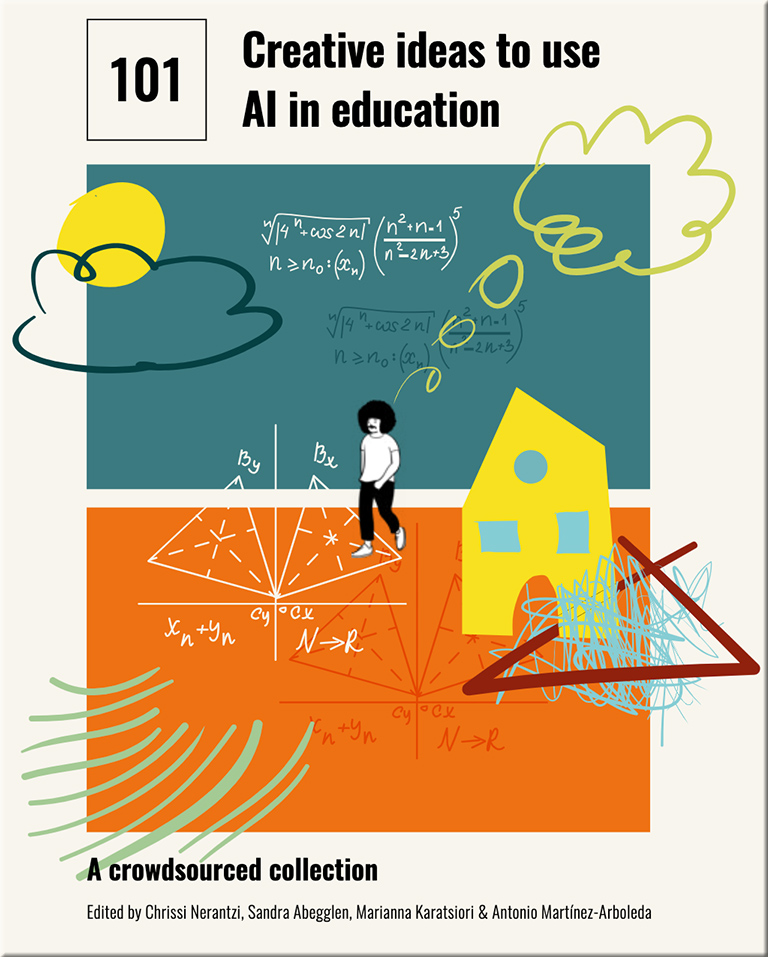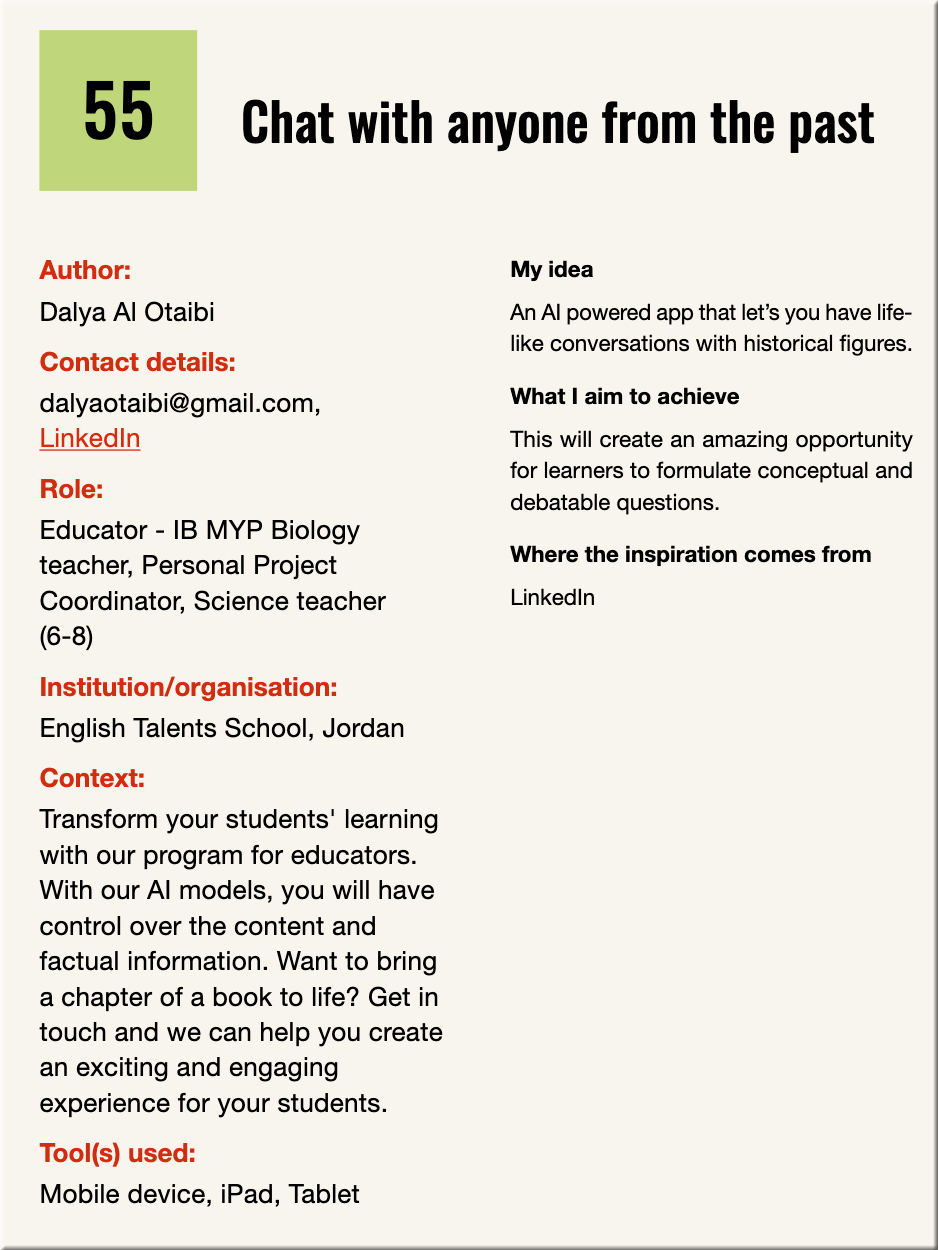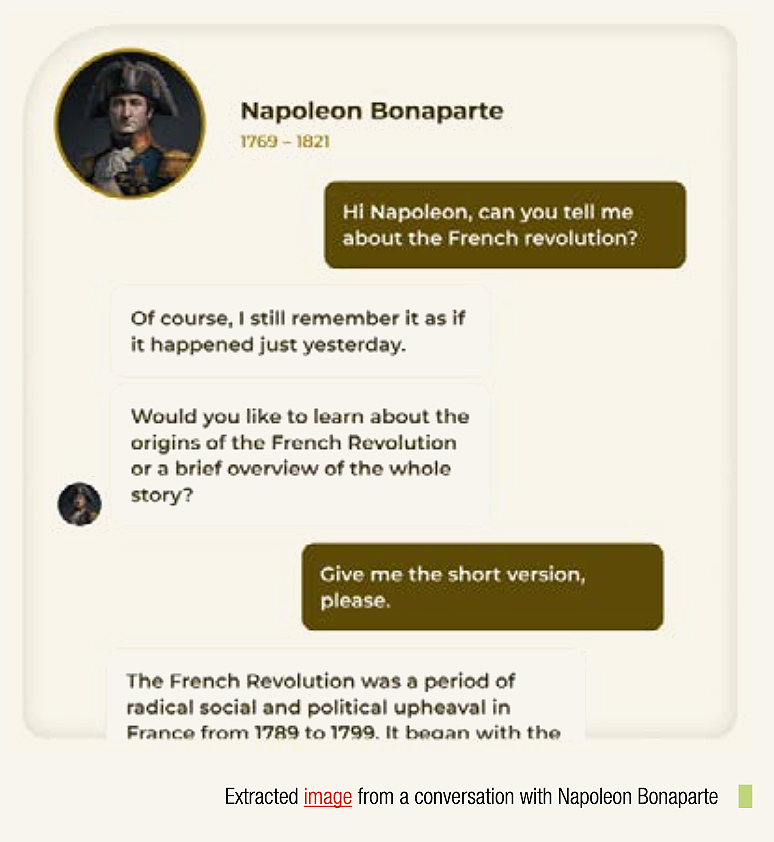DC: Is the future of one of our powerful learning ecosystems more like adding your own desired groups/cohorts, topics, items, etc. to your server? Like a learning-focused type of Discord service? (https://t.co/Vq4dZamBf2)#future #learningecosystems #personalizedlearning pic.twitter.com/wVMWYBN3R1
— Daniel Christian (he/him/his) (@dchristian5) August 17, 2023
What value do you offer? — from linkedin.com by Dan Fitzpatrick — The AI Educator
Excerpt (emphasis DSC):
So, as educators, mentors, and guides to our future generations, we must ask ourselves three pivotal questions:
- What value do we offer to our students?
- What value will they need to offer to the world?
- How are we preparing them to offer that value?
The answers to these questions are crucial, and they will redefine the trajectory of our education system.
We need to create an environment that encourages curiosity, embraces failure as a learning opportunity, and celebrates diversity. We need to teach our students how to learn, how to ask the right questions, and how to think for themselves.
5 Little-Known ChatGPT Prompts to Learn Anything Faster — from medium.com by Eva Keiffenheim
Including templates, you can copy.
Leveraging ChatGPT for learning is the most meaningful skill this year for lifelong learners. But it’s too hard to find resources to master it.
As a learning science nerd, I’ve explored hundreds of prompts over the past months. Most of the advice doesn’t go beyond text summaries and multiple-choice testing.
That’s why I’ve created this article — it merges learning science with prompt writing to help you learn anything faster.
Midjourney AI Art for Teachers (for any kind of teacher, not just Art Teachers) — from The AI Educator on YouTube by Dan Fitzpatrick
From DSC:
This is a very nice, clearly illustrated, free video to get started with the Midjourney (text-to-image) app. Nice work Dan!
Also see Dan’s
AI Generated Immersive Learning Series
What is Academic Integrity in the Era of Generative Artificial intelligence? — from silverliningforlearning.org by Chris Dede
In the new-normal of generative AI, how does one articulate the value of academic integrity? This blog presents my current response in about 2,500 words; a complete answer could fill a sizable book.
Massive amounts of misinformation are disseminated about generative AI, so the first part of my discussion clarifies what large language models (Chat-GPT and its counterparts) can currently do and what they cannot accomplish at this point in time. The second part describes ways in which generative AI can be misused as a means of learning; unfortunately, many people are now advocating for these mistaken applications to education. The third part describes ways in which large language models (LLM), used well, may substantially improve learning and education. I close with a plea for a robust, informed public discussion about these topics and issues.
Dr. Chris Dede and the Necessity of Training Students and Faculty to Improve Their Human Judgment and Work Properly with AIs — from stefanbauschard.substack.com by Stefan Bauschard
We need to stop using test-driven curriculums that train students to listen and to compete against machines, a competition they cannot win. Instead, we need to help them augment their Judgment.
The Creative Ways Teachers Are Using ChatGPT in the Classroom — from time.com by Olivia B. Waxman
Many of the more than a dozen teachers TIME interviewed for this story argue that the way to get kids to care is to proactively use ChatGPT in the classroom.
…
Some of those creative ideas are already in effect at Peninsula High School in Gig Harbor, about an hour from Seattle. In Erin Rossing’s precalculus class, a student got ChatGPT to generate a rap about vectors and trigonometry in the style of Kanye West, while geometry students used the program to write mathematical proofs in the style of raps, which they performed in a classroom competition. In Kara Beloate’s English-Language Arts class, she allowed students reading Shakespeare’s Othello to use ChatGPT to translate lines into modern English to help them understand the text, so that they could spend class time discussing the plot and themes.
AI in Higher Education: Aiding Students’ Academic Journey — from td.org by J. Chris Brown
Topics/sections include:
Automatic Grading and Assessment
AI-Assisted Student Support Services
Intelligent Tutoring Systems
AI Can Help Both Students and Teachers
Shockwaves & Innovations: How Nations Worldwide Are Dealing with AI in Education — from the74million.org by Robin Lake
Lake: Other countries are quickly adopting artificial intelligence in schools. Lessons from Singapore, South Korea, India, China, Finland and Japan.
I found that other developed countries share concerns about students cheating but are moving quickly to use AI to personalize education, enhance language lessons and help teachers with mundane tasks, such as grading. Some of these countries are in the early stages of training teachers to use AI and developing curriculum standards for what students should know and be able to do with the technology.
Several countries began positioning themselves several years ago to invest in AI in education in order to compete in the fourth industrial revolution.
AI in Education — from educationnext.org by John Bailey
The leap into a new era of machine intelligence carries risks and challenges, but also plenty of promise
In the realm of education, this technology will influence how students learn, how teachers work, and ultimately how we structure our education system. Some educators and leaders look forward to these changes with great enthusiasm. Sal Kahn, founder of Khan Academy, went so far as to say in a TED talk that AI has the potential to effect “probably the biggest positive transformation that education has ever seen.” But others warn that AI will enable the spread of misinformation, facilitate cheating in school and college, kill whatever vestiges of individual privacy remain, and cause massive job loss. The challenge is to harness the positive potential while avoiding or mitigating the harm.
Generative AI and education futures — from ucl.ac.uk
Video highlights from Professor Mike Sharples’ keynote address at the 2023 UCL Education Conference, which explored opportunities to prosper with AI as a part of education.
Bringing AI Literacy to High Schools — from by Nikki Goth Itoi
Stanford education researchers collaborated with teachers to develop classroom-ready AI resources for high school instructors across subject areas.
To address these two imperatives, all high schools need access to basic AI tools and training. Yet the reality is that many underserved schools in low-income areas lack the bandwidth, skills, and confidence to guide their students through an AI-powered world. And if the pattern continues, AI will only worsen existing inequities. With this concern top of mind plus initial funding from the McCoy Ethics Center, Lee began recruiting some graduate students and high school teachers to explore how to give more people equal footing in the AI space.
Excerpts from the Too Long Didn’t Read (TLDR) section from AIxEducation Day 1: My Takeaways — from stefanbauschard.substack.com by Stefan Bauschard (emphasis DSC)
* There was a lot of talk about learning bots. This talk included the benefits of 1:1 tutoring, access to education for those who don’t currently have it (developing world), the ability to do things for which we currently don’t have enough teachers and support staff (speech pathology), individualized instruction (it will be good at this soon), and stuff that it is already good at (24/7 availability, language tutoring, immediate feedback regarding argumentation and genre (not facts :), putting students on the right track, comprehensive feedback, more critical feedback).
* Students are united. The student organizers and those who spoke at the conference have concerns about future employment, want to learn to use generative AI, and express concern about being prepared for the “real world.” They also all want a say in how generative AI is used in the college classroom. Many professors spoke about the importance of having conversations with students and involving them in the creation of AI policies as well.
* I think it’s fair to say that all professors who spoke thought students were going to use generative AI regardless of whether or not it was permitted, though some hoped for honesty.
* No professor who spoke thought using a plagiarism detector was a good idea.
* Everyone thought that significant advancements in AI technology were inevitable.
* Almost everyone expressed being overwhelmed by the rate of change.
Stefan recommended the following resource:
-
- The Future of Higher Education — from/by Jeppe Klitgaard Stricker
10 ways for students to get repetitions for practice — from ditchthattextbook.com by Matt Miller
If we want students to remember – to lock new information or ideas into long-term memory – getting meaningful repetitions still is key. And the science of learning still backs that up.
So … if we want students to get repetitions to make new learning permanent, how can they do it? Here are 10 ways to help students get repetitions for practice – and how classroom technology can help.
MUST-TRY FIRST WEEK OF SCHOOL ACTIVITY IDEAS – EASY EDTECH PODCAST 225 — from classtechtips.com by Dr. Monica Burns
In this episode, I share ten engaging activities that combine education, technology, and plenty of fun to make the first week of class super memorable. From digital scavenger hunts to virtual field trips, hear about a few of my favorite ways to create an interactive start to your school year.
Tips for First Week of School Activity Ideas
- Establish routines in a fun way.
- Provide opportunities for collaboration.
- Introduce tech tools that will be used all year.
From DSC:
Dr. Burns has a great list of tools/tips/resources in this posting.
Teaching: What does it take to elevate good teaching? A lot. — from chronicle.com by Beth McMurtrie
Advice guides for teaching
As the fall approaches, we want to remind readers that The Chronicle offers a range of free advice guides designed to help improve your teaching. They’re written by experts for instructors who want to gather ideas on creating a syllabus, teaching a good first day of class, making your teaching more engaging, improving classroom discussion, making your teaching more inclusive and being a better online teacher.
Four directions for assessment redesign in the age of generative AI— from timeshighereducation.com by Julia Chen
The rise of generative AI has led universities to rethink how learning is quantified. Julia Chen offers four options for assessment redesign that can be applied across disciplines
Direction 1: From written description to multimodal explanation and application
Direction 2: From literature review alone to referencing lectures
Direction 3: From presentation of ideas to defence of views
Direction 4: From working alone to student-staff partnership
Absenteeism Mires Recovery from Pandemic Learning Losses — from educationnext.org by Phyllis W. Jordan
But simple measures by schools can encourage better student attendance
Excerpt (emphasis DSC):
With the latest national test results showing a dispiriting lack of progress in catching students up academically in the wake of the pandemic, one potential explanation stands out: stubbornly high rates of student absenteeism. Vast numbers of students haven’t returned to class regularly since schools reopened.
From DSC:
Shouldn’t that tell us something?
We’re rolling out a bunch of small updates to improve the ChatGPT experience. Shipping over the next week:
1. Prompt examples: A blank page can be intimidating. At the beginning of a new chat, you’ll now see examples to help you get started.
2. Suggested replies: Go deeper with…— OpenAI (@OpenAI) August 3, 2023
Gen-AI Movie Trailer For Sci Fi Epic “Genesis” — from forbes.com by Charlie Fink
The movie trailer for “Genesis,” created with AI, is so convincing it caused a stir on Twitter [on July 27]. That’s how I found out about it. Created by Nicolas Neubert, a senior product designer who works for Elli by Volkswagen in Germany, the “Genesis” trailer promotes a dystopian sci-fi epic reminiscent of the Terminator. There is no movie, of course, only the trailer exists, but this is neither a gag nor a parody. It’s in a class of its own. Eerily made by man, but not.
? Trailer: Genesis (Midjourney + Runway)
We gave them everything.
Trusted them with our world.
To become enslaved – become hunted.We have no choice.
Humanity must rise again to reclaim.Images: Midjourney
Videos: #Runway
Music: Pixabay / Stringer_Bell
Edited in: CapCut pic.twitter.com/zjeU7YPFh9— Nicolas Neubert (@iamneubert) July 26, 2023
Google’s water use is soaring. AI is only going to make it worse. — from businessinsider.com by Hugh Langley
Google just published its 2023 environmental report, and one thing is for certain: The company’s water use is soaring.
The internet giant said it consumed 5.6 billion gallons of water in 2022, the equivalent of 37 golf courses. Most of that — 5.2 billion gallons — was used for the company’s data centers, a 20% increase on the amount Google reported the year prior.
We think prompt engineering (learning to converse with an AI) is overrated. — from the Neuron
We think prompt engineering (learning to converse with an AI) is overrated. Yup, we said it. We think the future of chat interfaces will be a combination of preloading context and then allowing AI to guide you to the information you seek.
From DSC:
Agreed. I think we’ll see a lot more interface updates and changes to make things easier to use, find, develop.
Radar Trends to Watch: August 2023 — from oreilly.com by Mike Loukides
Developments in Programming, Web, Security, and More
Artificial Intelligence continues to dominate the news. In the past month, we’ve seen a number of major updates to language models: Claude 2, with its 100,000 token context limit; LLaMA 2, with (relatively) liberal restrictions on use; and Stable Diffusion XL, a significantly more capable version of Stable Diffusion. Does Claude 2’s huge context really change what the model can do? And what role will open access and open source language models have as commercial applications develop?
Try out Google ‘TextFX’ and its 10 creative AI tools for rappers, writers — from 9to5google.com by Abner Li; via Barsee – AI Valley
Google Lab Sessions are collaborations between “visionaries from all realms of human endeavor” and the company’s latest AI technology. [On 8/2/23], Google released TextFX as an “experiment to demonstrate how generative language technologies can empower the creativity and workflows of artists and creators” with Lupe Fiasco.
Google’s TextFX includes 10 tools and is powered by the PaLM 2 large language model via the PALM API. Meant to aid in the creative process of rappers, writers, and other wordsmiths, it is part of Google Labs.
A cam/mic/light/teleprompter remote kit for non-tech-savvy guests, including Shure MV7 — from provideocoalition.com by Allan Tépper
Excerpt (emphasis DSC):
Inspired by my recent Review: Shure MV7 dynamic hybrid studio microphone – near, far and beyond, Beaker Films of Fairfield, Connecticut, US has developed and deployed a first batch of 10 kits to capture remote conversations from different locations worldwide. Beaker Films is frequently contracted to record remote interviews or testimonials from medical professionals. For this project, Beaker Films’ clients wanted consistent, high quality audio and video, but with 3 additional challenges: they preferred to have no visible microphone in the shot, they needed a teleprompter function and the whole kit needed to be as simple as possible for non-technical guests.
Speaking of A/V-related items, also see:
Seven worlds one planet at the BBC Earth Experience — from inavateonthenet.net by Paul Milligan
‘Holographic’ animal-free zoo opens in Australia — from inavateonthenet.net
XR Lab opens in UK college — from inavateonthenet.net
West Suffolk College in the UK has opened its Extended Reality Lab (XR Lab), the facilities comprise of four distinct areas: an Immersion Lab, a Collaboration Theatre, a Green Room, and a Conference Room. The project was designed by architects WindsorPatania for Eastern Colleges Group.
CJP to create virtual studio for Solent University — from inavateonthenet.net
Systems integrator CJP Broadcast Service Solutions, has won a tender to build a virtual production environment for Solent University in the UK.
The new facilities, converted from an existing studio space, will provide students on the film production courses with outstanding opportunities to develop their creative output.
Generative AI and the future of work in America — from mckinsey.com by Kweilin Ellingrud, Saurabh Sanghvi, Gurneet Singh Dandona, Anu Madgavkar, Michael Chui, Olivia White, and Paige Hasebe
At a glance
- During the pandemic (2019–22), the US labor market saw 8.6 million occupational shifts, 50 percent more than in the previous three-year period.
- By 2030, activities that account for up to 30 percent of hours currently worked across the US economy could be automated—a trend accelerated by generative AI.
- Federal investment to address climate and infrastructure, as well as structural shifts, will also alter labor demand.
- An additional 12 million occupational transitions may be needed by 2030.
- The United States will need workforce development on a far larger scale as well as more expansive hiring approaches from employers.
Employers will need to hire for skills and competencies rather than credentials, recruit from overlooked populations (such as rural workers and people with disabilities), and deliver training that keeps pace with their evolving needs.
The AI-Powered, Totally Autonomous Future of War Is Here — from wired.com by Will Knight
Ships without crews. Self-directed drone swarms. How a US Navy task force is using off-the-shelf robotics and artificial intelligence to prepare for the next age of conflict.
From DSC:
Hhhhmmmmm…..not good. Is anyone surprised by this? No, I didn’t think so either. That’s why the United States and China are so heated up about semiconductor chips.
AI puts glitch in graduates’ employment plans — from hrdive.com by Ginger Christ
Recent grads are worried how AI will affect their career prospects, a new survey found.
Excerpt:
- The proliferation of new technologies like generative artificial intelligence is making recent graduates uneasy, a new study released Thursday found. A third of the 1,000 people who graduated in the past year said they are second-guessing their career choice, while roughly half reported questioning their workforce preparedness and feeling threatened by AI, according to the 2023 Employability Report by Cengage Group, a global education technology company.
“The workplace has changed rapidly in the last few years, and now we are witnessing a new shift as AI begins to reshape worker productivity, job requirements, hiring habits and even entire industries,” Michael Hansen, Cengage Group CEO, said in a news release.
Along these lines, also see:
AI Boom Creates Concerns for Recent Graduates — from insidehighered.com by Lauren Coffey
More than half of recent graduates question whether they are properly prepared for the workforce in light of the rise of artificial intelligence, a survey finds.
…
There is also more of a preference for skills training credentials. Among employers, nearly 40 percent said skills training credentials are most important, while only 19 percent ranked a college degree as most important.
…
However, recent graduates did cite an issue with most higher education institutions’ ability to teach employability skills. In 2023, 43 percent of students said their degree program taught them the necessary skills for their first job, down 20 percentage points from 2022.
Instructure, Khan Academy Announce Major Partnership On AI Tutoring, Teaching
— from forbes.com by Derek Newton
The news is that Instructure, one of the few public education companies and the market leader in learning management with their signature product Canvas, struck a partnership with Khan Academy to create an AI-powered tutoring and teaching assistant tool – merging Khan’s innovative instructional content and Instructure’s significant reach, scale, and data insights. The partnership and related tools will be known as Khanmigo, according to the announcement.
On brand names alone, this is a big deal. On potential impact, it could be even bigger.
How To Use AI to Write Scenarios — from christytuckerlearning.com by Christy Tucker
How can you use AI to write scenarios for learning? Read this example with prompts and results using ChatGPT and Bard.
Excerpts:
So far, I have found these tools helpful in generating ideas, writing first drafts, and summarizing. They work better for general knowledge tasks than really specific topics unless I provide more details to them, which makes sense.
This post isn’t going to give you “5 magical prompts to instantly write scenarios for you” or anything like that. Instead, this is a “working out loud” post where I’ll share some prompts I have used.
Christy’s posting includes:
- “The Meeting from Hell”
- “The Backstabbing Coworker”
- “The Boss from Hell”
- “The Office Romance Gone Wrong”
- “The New Hire with Attitude”
Some potential tools for you to check out:
- 15 Best AI Tools for Education in 2023 — finance.yahoo.com by Maliha Shaikh
DC: I’m sympathetic to those who are supposed to be making policy when what we’re dealing with continues to evolve/change so quickly. https://t.co/1KB8dSFWaO
— Daniel Christian (he/him/his) (@dchristian5) July 27, 2023
The Rise of the Talent Economy — from drphilippahardman.substack.com by Dr. Philippa Hardman
How Education & Training Will Dictate the Future & Impact of AI
“Talent, more than capital, will represent the critical factor of production.”
…
In short, the demand for AI skills requires a significant transformation in training and education models. To bridge the global skills gap, educational institutions, online learning providers, and employers must design and deliver training programs that cater to the rapidly evolving AI-driven labor market.
How ChatGPT killed my discussion boards and prompted new prompts — from timeshighereducation.com by Sara Cline; per Robert Gibson on LinkedIn
Advice on learning and discussion prompts that require students to think beyond the remit of AI responses
Excerpts:
To combat this problem, we modified some of our prompts this summer to try to prevent students from using AI to avoid learning. I’m sharing some of our strategies in the hope that they help you out as you adapt your course to a world of generative AI.
- Use prompts that force a personal opinion.
- Have students include their source(s) as an attachment.
- Use current or local events.
- Have them take and caption a photo.
- Draw a diagram or chart.
- Build and explain a 3D model.
- Include timestamps from lecture videos.
- Scrap the discussion boards.
Dark web ChatGPT is here… — from therundown.ai
The Rundown: A new cybercrime generative AI tool called FraudGPT is being advertised on the Dark web and Telegram channels, offering offensive capabilities like crafting spear-phishing emails and creating undetectable malware.
…
Why it matters: Scammers can now look more realistic than ever before and at a larger scale. The sad truth is that the emergence of cybercrime AI tools like FraudGPT is just beginning.
From DSC:
If true and if it could help build and/or contribute to cloud-based learner profiles, this could be huge.
#Linkedin is working on LinkedIn Coach!
It’s an AI ASSISTANT that helps you apply for JOBS, learn new SKILLS, and find more ways to CONNECT with your network! pic.twitter.com/jKBrPmEFJt
— Nima Owji (@nima_owji) July 27, 2023
Wayfair’s AI tool can redraw your living room and sell you furniture — from theverge.com by Wes Davis
The home decoration company’s new Decorify AI remodeling tool is clumsy but could be effective for visualization while remodeling.
22 Classroom-Focused Resources on AI from Teachers Everywhere — from coolcatteacher.com by Vicki Davis; via GSV
***
I get weary of AI hype auto-generated by *gasp* ChatGPT without any real applicability to the classroom. I’m collecting blogs of teachers who are in the classroom actually use AI and have practical, real examples to share. Got links for those teachers? Enough of the junk.
— Vicki Davis (@coolcatteacher) July 25, 2023
Back to School Survey: 44% of Teens “Likely” to Use AI To Do Their Schoolwork for Them This School Year — from prnewswire.com by Junior Achievement
Research by Junior Achievement Shows 60% of Teens Consider the Use of AI to Do Their Schoolwork for Them as “Cheating”
Excerpt:
COLORADO SPRINGS, Colo., July 26, 2023 /PRNewswire/ — A new survey of teens conducted for Junior Achievement by the research firm Big Village shows that nearly half of teens (44%) are “likely” to use AI to do their schoolwork instead of doing it themselves this coming school year. However, most teens (60%) consider using AI in this way as “cheating.” The survey of 1,006 13- to 17-year-olds was conducted by Big Village from July 6 through 11, 2023.
From DSC:
In a competitive society as we have in the U.S. and when many of our K-12 learning ecosystems are designed to create game players, we shouldn’t be surprised to see a significant amount of our students using AI to “win”/game the system.
As it becomes appropriate for each student, offering more choice and control should help to allow more students to pursue what they want to learn about. They won’t be as interested in gaming the system if they truly want to learn about something.
YouTube tests AI-generated quizzes on educational videos — from techcrunch.com by Lauren Forristal
YouTube is experimenting with AI-generated quizzes on its mobile app for iOS and Android devices, which are designed to help viewers learn more about a subject featured in an educational video. The feature will also help the video-sharing platform get a better understanding of how well each video covers a certain topic.
Incorporating AI in Teaching: Practical Examples for Busy Instructors — from danielstanford.substack.com by Daniel Stanford; with thanks to Derek Bruff on LinkedIn for the resource
Since January 2023, I’ve talked with hundreds of instructors at dozens of institutions about how they might incorporate AI into their teaching. Through these conversations, I’ve noticed a few common issues:
- Faculty and staff are overwhelmed and burned out. Even those on the cutting edge often feel they’re behind the curve.
- It’s hard to know where to begin.
- It can be difficult to find practical examples of AI use that are applicable across a variety of disciplines.
To help address these challenges, I’ve been working on a list of AI-infused learning activities that encourage experimentation in (relatively) small, manageable ways.
September 2023: The Secret Intelligent Beings on Campus — from stefanbauschard.substack.com by Stefan Bauschard
Many of your students this fall will be enhanced by artificial intelligence, even if they don’t look like actual cyborgs. Do you want all of them to be enhanced, or just the highest SES students?
How to report better on artificial intelligence — from cjr.org (Columbia Journalism Review) by Syash Kapoor, Hilke Schellmann, and Ari Sen
In the past few months we have been deluged with headlines about new AI tools and how much they are going to change society.
Some reporters have done amazing work holding the companies developing AI accountable, but many struggle to report on this new technology in a fair and accurate way.
We—an investigative reporter, a data journalist, and a computer scientist—have firsthand experience investigating AI. We’ve seen the tremendous potential these tools can have—but also their tremendous risks.
As their adoption grows, we believe that, soon enough, many reporters will encounter AI tools on their beat, so we wanted to put together a short guide to what we have learned.
.
DSC:
Something I created via Adobe Firefly (Beta version)
The 5 reasons L&D is going to embrace ChatGPT — from chieflearningoffice.com by Josh Bersin
Does this mean it will do away with the L&D job? Not at all — these tools give you superhuman powers to find content faster, put it in front of employees in a more useful way and more creatively craft character simulations, assessments, learning in the flow of work and more.
And it’s about time. We really haven’t had a massive innovation in L&D since the early days of the learning experience platform market, so we may be entering the most exciting era in a long time.
Let me give you the five most significant use cases I see. And more will come.
AI and Tech with Scenarios: ID Links 7/11/23 — from christytuckerlearning.com by Christy Tucker
As I read online, I bookmark resources I find interesting and useful. I share these links periodically here on my blog. This post includes links on using tech with scenarios: AI, xAPI, and VR. I’ll also share some other AI tools and links on usability, resume tips for teachers, visual language, and a scenario sample.
It’s only a matter of time before A.I. chatbots are teaching in primary schools — from cnbc.com by Mikaela Cohen
Key Points
- Microsoft co-founder Bill Gates saying generative AI chatbots can teach kids to read in 18 months rather than years.
- Artificial intelligence is beginning to prove that it can accelerate the impact teachers have on students and help solve a stubborn teacher shortage.
- Chatbots backed by large language models can help students, from primary education to certification programs, self-guide through voluminous materials and tailor their education to specific learning styles [preferences].
The Rise of AI: New Rules for Super T Professionals and Next Steps for EdLeaders — from gettingsmart.com by Tom Vander Ark
Key Points
- The rise of artificial intelligence, especially generative AI, boosts productivity in content creation–text, code, images and increasingly video.
- Here are six preliminary conclusions about the nature of work and learning.
The Future Of Education: Embracing AI For Student Success — from forbes.com by Dr. Michael Horowitz
Unfortunately, too often attention is focused on the problems of AI—that it allows students to cheat and can undermine the value of what teachers bring to the learning equation. This viewpoint ignores the immense possibilities that AI can bring to education and across every industry.
The fact is that students have already embraced this new technology, which is neither a new story nor a surprising one in education. Leaders should accept this and understand that people, not robots, must ultimately create the path forward. It is only by deploying resources, training and policies at every level of our institutions that we can begin to realize the vast potential of what AI can offer.
AI Tools in Education: Doing Less While Learning More — from campustechnology.com by Mary Grush
A Q&A with Mark Frydenberg
Why Students & Teachers Should Get Excited about ChatGPT — from ivypanda.com with thanks to Ruth Kinloch for this resource
Excerpt re: Uses of ChatGPT for Teachers
- Diverse assignments.
- Individualized approach.
- Interesting classes.
- Debates.
- Critical thinking.
- Grammar and vocabulary.
- Homework review.
SAIL: State of Research: AI & Education — from buttondown.email by George Siemens
Information re: current AI and Learning Labs, education updates, and technology
Why ethical AI requires a future-ready and inclusive education system — from weforum.org
A specter is haunting higher education — from aiandacademia.substack.com by Bryan Alexander
Fall semester after the generative AI revolution
In this post I’d like to explore that apocalyptic model. For reasons of space, I’ll leave off analyzing student cheating motivations or questioning the entire edifice of grade-based assessment. I’ll save potential solutions for another post.
Let’s dive into the practical aspects of teaching to see why Mollick and Bogost foresee such a dire semester ahead.
Items re: Code Interpreter
Code Interpreter becoming available for all ChatGPT Plus users over the next week. Really amazing for any data science use case: https://t.co/hpel8xKyEg pic.twitter.com/Fd3SnPvVmT
— Greg Brockman (@gdb) July 6, 2023
I put together an initial prompt to set up Code Interpreter to create useful data visualizations. It gives it some basic principles of good chart design & also reminds it that it can output many kinds of files.
It is a first draft, feel free to improve: https://t.co/m4yAdKROiJ pic.twitter.com/r5A7PznqSC
— Ethan Mollick (@emollick) July 10, 2023
- What AI can do with a toolbox… Getting started with Code Interpreter — from oneusefulthing.org by Ethan Mollick
Democratizing data analysis with AI
Code Interpreter continues OpenAI’s long tradition of giving terrible names to things, because it might be most useful for those who do not code at all. It essentially allows the most advanced AI available, GPT-4, to upload and download information, and to write and execute programs for you in a persistent workspace. That allows the AI to do all sorts of things it couldn’t do before, and be useful in ways that were impossible with ChatGPT.
.
BREAKING: Code Interpreter is FINALLY rolling out to all ChatGPT Plus users.
It’s the most powerful feature OpenAI has released since GPT-4. It makes everyone a data analyst.
Here are 15 mind-blowing use cases of Code Interpreter: pic.twitter.com/qX0txynENS
— Aakash Gupta ? Product Growth Guy (@aakashg0) July 7, 2023
Legal items
- 2 authors say OpenAI ‘ingested’ their books to train ChatGPT. Now they’re suing, and a ‘wave’ of similar court cases may follow. — from businessinsider.com by Gabriel Rivera
- Authors Are Suing OpenAI & Meta For Copyright Infringement — from theneurondaily.com by Noah Edelman
MISC items
- America’s first law regulating AI bias in hiring takes effect this week — from downes.ca by Stephen Downes
- Eric Schmidt: This is how AI will transform the way science gets done — from technologyreview.com by Eric Schmidt
Science is about to become much more exciting—and that will affect us all, argues Google’s former CEO. - Microsoft unveils first professional certificate for generative AI skills — from zdnet.com/ by Lance Whitney
With the new AI Skills Initiative, people can take free online training via LinkedIn to learn concepts of AI good toward a Career Essentials certificate. - What is Claude 2? How to access this ChatGPT competitor. — from mashable.com by Cecily Mauran
It’s a decent alternative, and it’s easy to use. - Claude 2 — from anthropic.com
Gen Z values education — but doesn’t think a four-year degree is the only option — from highereddive.com by Laura Spitalniak
Dive Brief:
- The current cohort of high school students, part of Generation Z, values postsecondary education but is increasingly interested in alternatives to four-year colleges, according to a new report from ECMC Group, a nonprofit focused on student success, and Vice Media.
- In 2023, 65% of surveyed students said they would need education beyond high school, compared to 59% pre-pandemic, the report said. But 59% said they could be successful if they don’t get a four-year degree
- Almost half, 48%, of high schoolers said their postsecondary education would ideally take three years or less, and just over a third, 35%, said it should take two years or less.
DC: #HigherEducation needs more efforts like this. We need to provide much more lifelong learning opportunities and more design thinking to create more cradle-to-grave #learningecosystems.https://t.co/Uro6XjhVm0
— Daniel Christian (he/him/his) (@dchristian5) July 7, 2023
From DSC:
And some further comments on that article:
Rather than looking to modify the traditional higher education structures for 18-year-olds fresh out of high school, the College for Adult Learners and Continuing Education will establish its own processes for the nontraditional student.
The average age of students enrolled in the Center for Distance Education is 32, and many have kids or other life responsibilities that impact their time and ability to focus on education, Seal explains.
“It’s not so much that we’re competing with other institutions [for adult learners], it’s that we’re competing with life,” Seal says. “They’re not leaving to go to another institution—they’re leaving because of life things.”
Some resources and reflections from Stephen Downes:
- Innovating Pedagogy 2023
- Paying a real living wage demonstrates commitment to higher education’s values
- Nigerian engineering students’ favorite teachers are Indian YouTubers
Online Learning Still in High Demand at Community Colleges — from insidehighered.com by Sara Weissman
Some colleges are still offering half or the majority of their classes online in response to student demand.
East Los Angeles College, the most populous campus in the California Community College system, offered 60 percent of its courses in a hybrid or online format this past spring, most of them asynchronous. Prior to the COVID-19 pandemic, fewer than a quarter of courses were offered online.
…
He said students have made their preferences clear via their enrollment trends—online course sections at the college have filled much more quickly lately than in-person courses.
Teaching: Does higher education value good teaching? — from chronicle.com by Beth McMurtrie; possible paywall but at least must have an account
Excerpt:
But the bigger question hanging over the conference was this: Do colleges actually value good teaching? On the one hand, it would seem obvious that they must. Undergraduate education is the central reason most colleges exist. How could you not value your core product?
But look below the surface and what do you see? An industry in which the majority of instructors are adjuncts who are often low-paid and unlikely to receive any sort of professional development, let alone an office in which to meet with students after class. At research universities you will find many tenure-track professors who were warned not to devote too much time to teaching before securing tenure, since scholarship is what’s rewarded. Promotion and tenure policies on many campuses, research-intensive or not, over-rely on student evaluations when it comes to judging teaching expertise or commitment. Finally, given that most doctoral programs devote a nominal amount of time to teaching students how to teach, it’s easy to see why many professors stick to how they were taught as students, whether or not those methods were effective.
Presenting to the Association of University Architects — from darcynorman.net by D’Arcy Norman, PhD
Excerpt:
Recently, I had the absolute pleasure to be invited to co-present at the 67th Annual Association of University Architects Conference, conveniently hosted this year in Calgary, and even more conveniently having one day’s sessions housed within the Taylor Institute for Teaching and Learning. Our Vice Provost Teaching and Learning, Dr. Leslie Reid, was invited to share her experience in leading the Taylor Institute, and she brought in Dr. Natasha Kenny and myself to round out the session.
In planning for the session, we decided early on that we didn’t want to do A Presentation™. There would not be slides and slides of text, and no bullet points. We wanted to tell stories, and to learn from the ~100 expert university architects from across North America about how they approach the challenges we’ve faced in the last few years.
We broke the storytelling portion of the session into 3 parts:
- Universality: Building for all or building for some (Leslie)
- Planning: Tension between form and function (Natasha)
- Flexibility: How to be flexible about flexibility (D’Arcy)
Recording Arts as Reengagement, Social Justice and Pathway — from gettingsmart.com
Key Points
- After a successful career as a recording artist, David “TC” Ellis created Studio 4 in St. Paul to spot budding music stars.
- It became a hangout spot for creative young people, most of whom had “dropped out of school due to boredom and a sense that school wasn’t relevant to their lives and dreams.”
- Ellis and colleagues then opened the High School for Recording Arts in 1998.
AI for Education Webinars — from youtube.com by Tom Barrett and others
Post-AI Assessment Design — from drphilippahardman.substack.com by Dr. Philippa Hardman
A simple, three-step guide on how to design assessments in a post-AI world
Excerpt:
Step 1: Write Inquiry-Based Objectives
Inquiry-based objectives focus not just on the acquisition of knowledge but also on the development of skills and behaviours, like critical thinking, problem-solving, collaboration and research skills.
They do this by requiring learners not just to recall or “describe back” concepts that are delivered via text, lecture or video. Instead, inquiry-based objectives require learners to construct their own understanding through the process of investigation, analysis and questioning.
.
Massive Disruption Now: What AI Means for Students, Educators, Administrators and Accreditation Boards
— from stefanbauschard.substack.com by Stefan Bauschard; via Will Richardson on LinkedIn
The choices many colleges and universities make regarding AI over the next 9 months will determine if they survive. The same may be true for schools.
Excerpts:
Just for a minute, consider how education would change if the following were true –
- AIs “hallucinated” less than humans
- AIs could write in our own voices
- AIs could accurately do math
- AIs understood the unique academic (and eventually developmental) needs of each student and adapt instruction to that student
- AIs could teach anything any student wanted or need to know any time of day or night
- AIs could do this at a fraction of the cost of a human teacher or professor
Fall 2026 is three years away. Do you have a three year plan? Perhaps you should scrap it and write a new one (or at least realize that your current one cannot survive). If you run an academic institution in 2026 the same way you ran it in 2022, you might as well run it like you would have in 1920. If you run an academic institution in 2030 (or any year when AI surpasses human intelligence) the same way you ran it in 2022, you might as well run it like you would have in 1820. AIs will become more intelligent than us, perhaps in 10-20 years (LeCun), though there could be unanticipated breakthroughs that lower the time frame to a few years or less (Benjio); it’s just a question of when, not “if.”
On one creative use of AI — from aiandacademia.substack.com by Bryan Alexander
A new practice with pedagogical possibilities
Excerpt:
Look at those material items again. The voiceover? Written by an AI and turned into audio by software. The images? Created by human prompts in Midjourney. The music is, I think, human created. And the idea came from a discussion between a human and an AI?
…
How might this play out in a college or university class?
Imagine assignments which require students to craft such a video. Start from film, media studies, or computer science classes. Students work through a process:
Generative Textbooks — from opencontent.org by David Wiley
Excerpt (emphasis DSC):
I continue to try to imagine ways generative AI can impact teaching and learning, including learning materials like textbooks. Earlier this week I started wondering – what if, in the future, educators didn’t write textbooks at all? What if, instead, we only wrote structured collections of highly crafted prompts? Instead of reading a static textbook in a linear fashion, the learner would use the prompts to interact with a large language model. These prompts could help learners ask for things like:
- overviews and in-depth explanations of specific topics in a specific sequence,
- examples that the learner finds personally relevant and interesting,
- interactive practice – including open-ended exercises – with immediate, corrective feedback,
- the structure of the relationships between ideas and concepts,
- etc.
Also relevant/see:
.
Generating The Future of Education with AI — from aixeducation.com
Designed for K12 and Higher-Ed Educators & Administrators, this conference aims to provide a platform for educators, administrators, AI experts, students, parents, and EdTech leaders to discuss the impact of AI on education, address current challenges and potentials, share their perspectives and experiences, and explore innovative solutions. A special emphasis will be placed on including students’ voices in the conversation, highlighting their unique experiences and insights as the primary beneficiaries of these educational transformations.
How Teachers Are Using ChatGPT in Class — from edweek.org by Larry Ferlazzo
Excerpt:
The use of generative AI in K-12 settings is complex and still in its infancy. We need to consider how these tools can enhance student creativity, improve writing skills, and be transparent with students about how generative AI works so they can better understand its limitations. As with any new tech, our students will be exposed to it, and it is our task as educators to help them navigate this new territory as well-informed, curious explorers.
Japan emphasizes students’ comprehension of AI in new school guidelines — from japantimes.co.jp by Karin Kaneko; via The Rundown
Excerpt:
The education ministry has emphasized the need for students to understand artificial intelligence in new guidelines released Tuesday, setting out how generative AI can be integrated into schools and the precautions needed to address associated risks.
Students should comprehend the characteristics of AI, including its advantages and disadvantages, with the latter including personal information leakages and copyright infringement, before they use it, according to the guidelines. They explicitly state that passing off reports, essays or any other works produced by AI as one’s own is inappropriate.
AI’s Teachable Moment: How ChatGPT Is Transforming the Classroom — from cnet.com by Mark Serrels
Teachers and students are already harnessing the power of AI, with an eye toward the future.
Excerpt:
Thanks to the rapid development of artificial intelligence tools like Dall-E and ChatGPT, my brother-in-law has been wrestling with low-level anxiety: Is it a good idea to steer his son down this path when AI threatens to devalue the work of creatives? Will there be a job for someone with that skill set in 10 years? He’s unsure. But instead of burying his head in the sand, he’s doing what any tech-savvy parent would do: He’s teaching his son how to use AI.
In recent months the family has picked up subscriptions to AI services. Now, in addition to drawing and sculpting and making movies and video games, my nephew is creating the monsters of his dreams with Midjourney, a generative AI tool that uses language prompts to produce images.
The AI Dictionary for Educators — from blog.profjim.com
To bridge this knowledge gap, I decided to make a quick little dictionary of AI terms specifically tailored for educators worldwide. Initially created for my own benefit, I’ve reworked my own AI Dictionary for Educators and expanded it to help my fellow teachers embrace the advancements AI brings to education.
7 Strategies to Prepare Educators to Teach With AI — from edweek.org by Lauraine Langreo; NOTE: Behind paywall
Who Does the Thinking: The Role of Generative AI in Higher Education — from youtube.com by Trine Jensen, Chris Dede, Frank Tsiwah, and Kate Thompson
Description:
Generative AI has taken the world by storm since OpenAI launched ChatGPT-3 in November 2022. Generative AI is characterized by its capacity to generate human-like content based on deep learning models in response to prompts. There is a wealth of opinions about how this will impact higher education spanning from the need to limit the use in the protection of higher education to embracing the tool as a means to improve higher education. In this webinar session, speakers from different regions shared their views and perspectives and discuss how Generative AI will transform higher education. What are the challenges to be addressed and which opportunities can be pursued to improve the quality of higher education? Watch the webinar and learn about the uncertainties, tensions, and opportunities triggered by Generative AI.
Trust and Transparency Are Key Factors When Using AI in Academia — from by Dr. Andrew Lang
Much can be learned from embracing artificial intelligence in the teaching and learning process. Here, two professors share their experiences using ChatGPT freely in the classroom.
A Professor Encouraged Students to Use ChatGPT. OpenAI Asked Her What She Learned — from techlearning.com by Erik Ofgang
Dr. Francine Berman permitted her students at UMass to use ChatGPT to help them write. Despite limitations, she found there were ways it could help edit student work.
Artificial intelligence glossary: 60+ terms to know — from techtarget.com by Ben Lutkevich
AI is moving fast and can be hard to keep up in real time. Use this glossary as a reference for AI terms.
The AI-Education Divide — from drphilippahardman.substack.com by Philippa Hardman
How the rise of AI has reinforced inequity in education (and what we need to do to reverse it)
.
101 creative ideas to use AI in education, A crowdsourced collection — from zenodo.org by Chrissi Nerantzi, Sandra Abegglen, Marianna Karatsiori, & Antonio Martínez-Arboleda (Eds.); with thanks to George Veletsianos for this resource
As an example, here’s one of the ideas from the crowdsourced collection:
On a somewhat related note, also see:
Merlyn Mind launches education-focused LLMs for classroom integration of generative AI — from venturebeat.com by Victor Dey
Excerpt:
Merlyn Mind, an AI-powered digital assistant platform, announced the launch of a suite of large language models (LLMs) specifically tailored for the education sector under an open-source license.
Designing courses in an age of AI — from teachinginhighered.com by Maria Andersen
Maria Andersen shares about designing courses in an age of artificial intelligence (AI) on episode 469 of the Teaching in Higher Ed podcast.
With generative AI, we have an incredible acceleration of change happening.
Maria Andersen









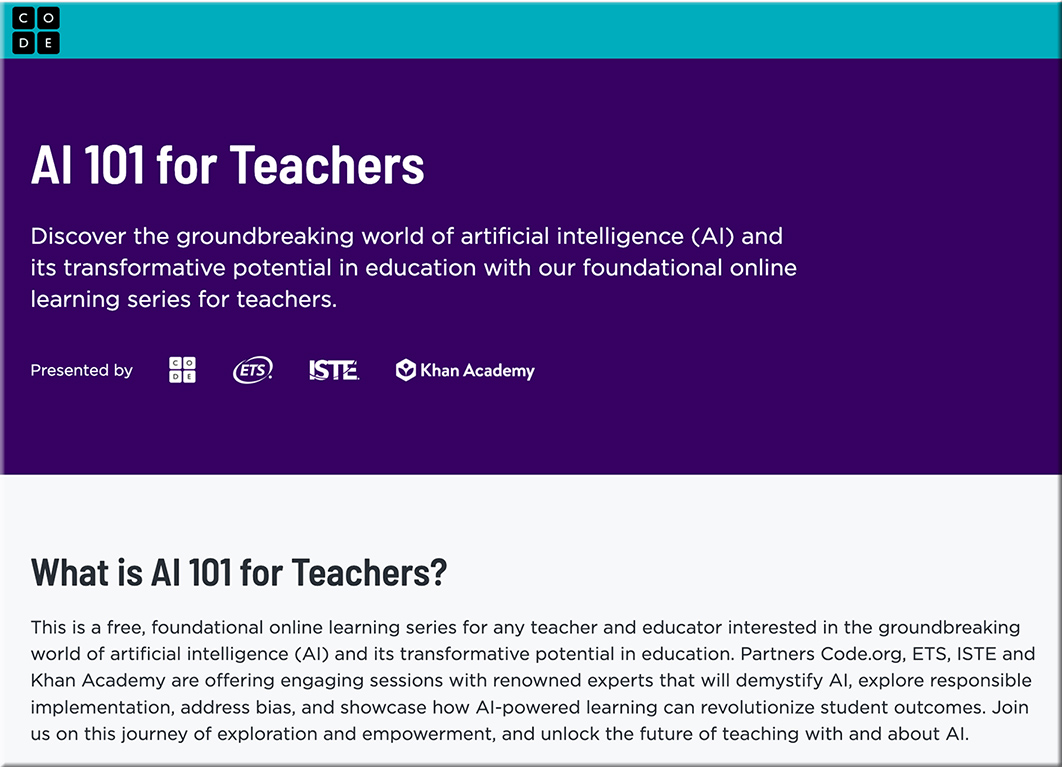
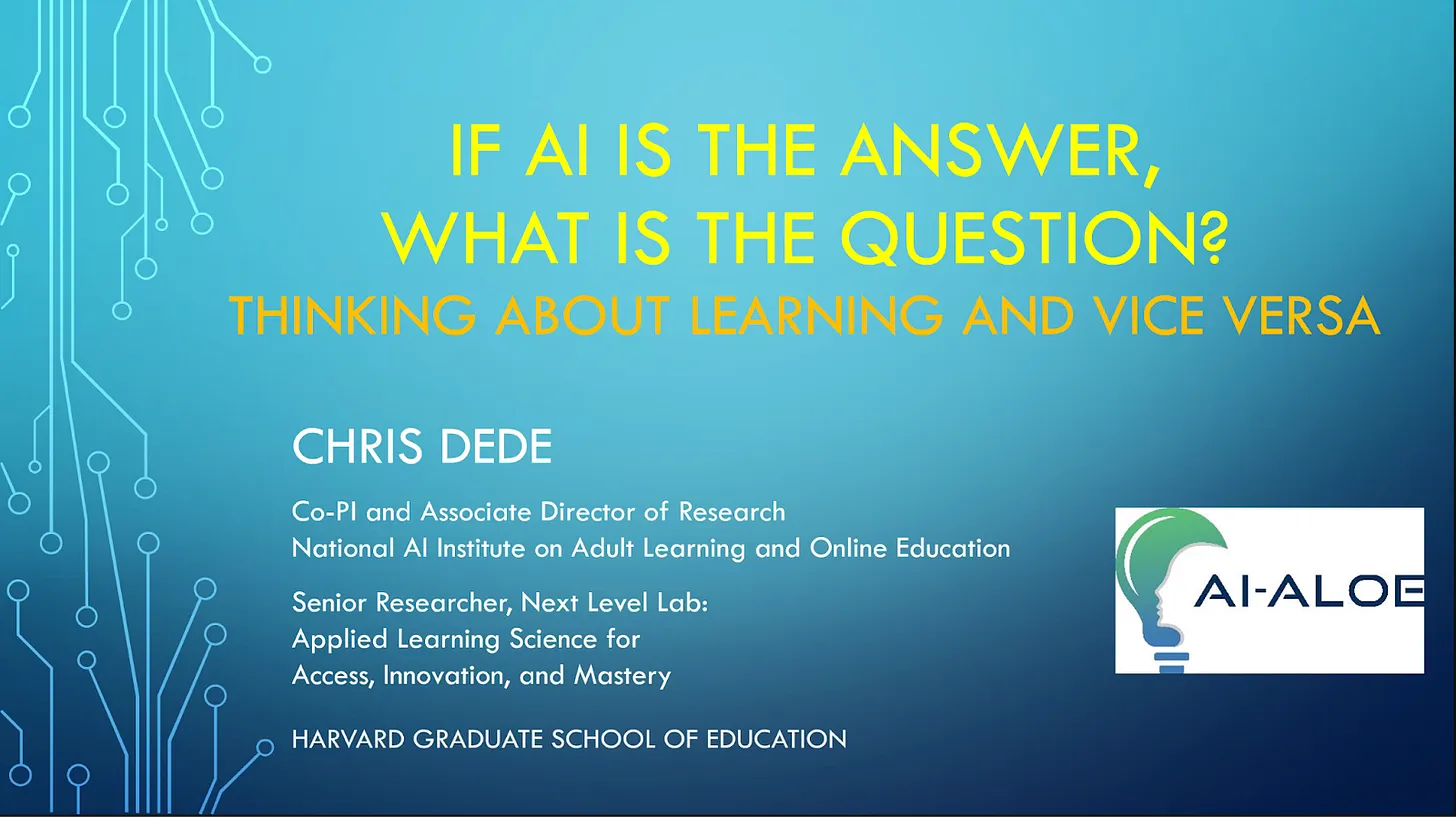
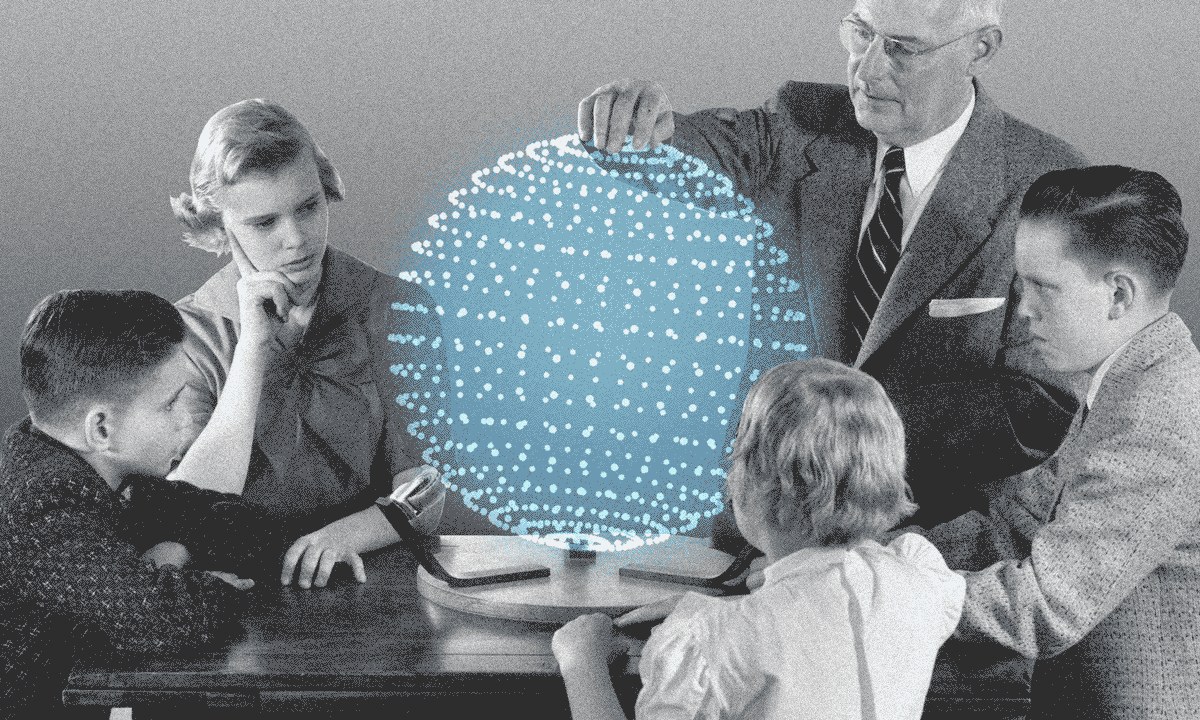

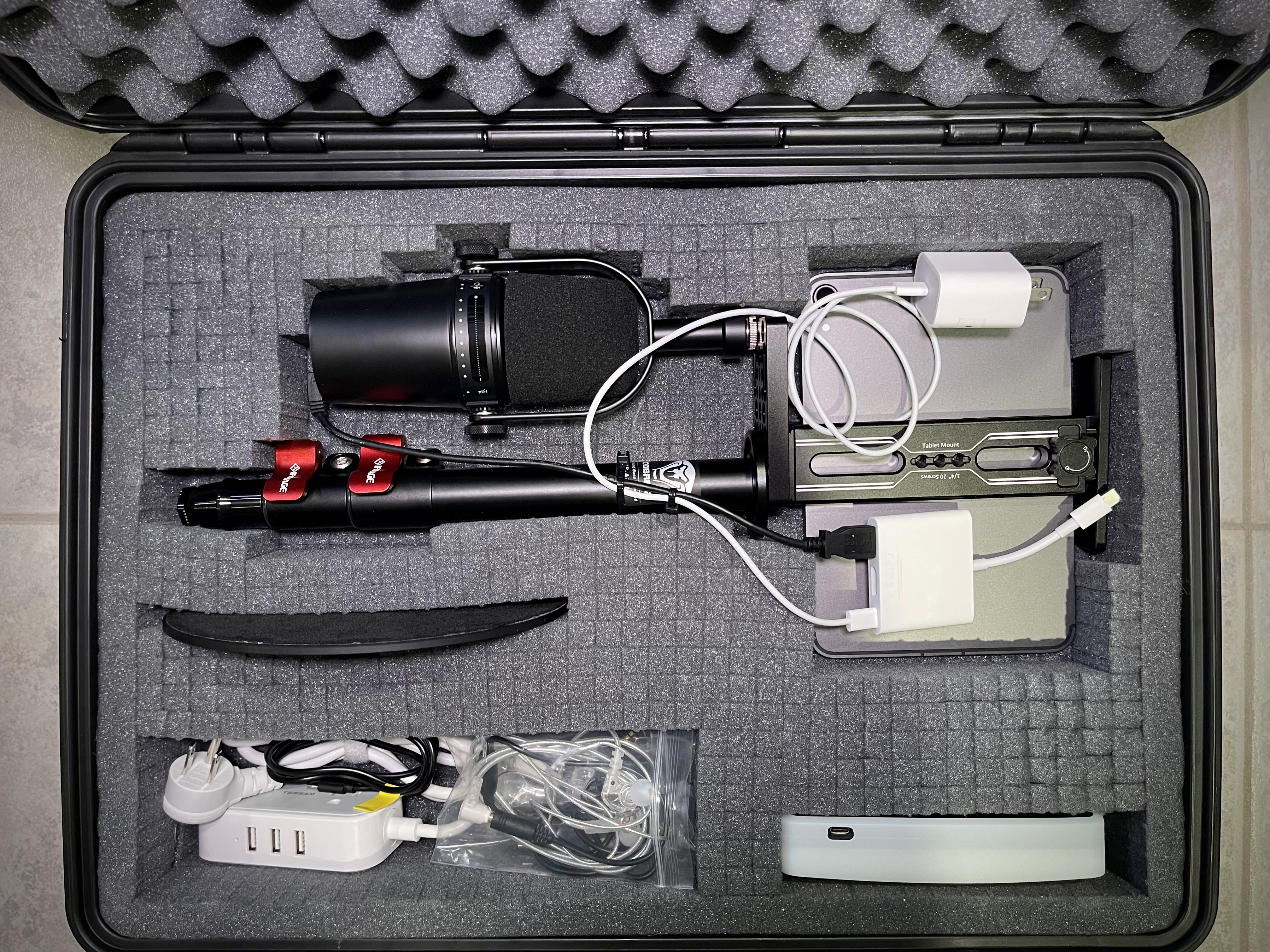

:format(webp)/cdn.vox-cdn.com/uploads/chorus_asset/file/24807167/Screenshot_2023_07_24_at_3.34.42_PM.png)

